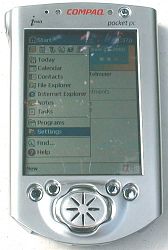
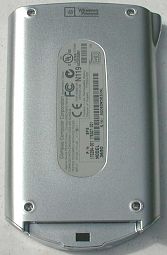
| Official
Gadgeteer Hands On Review: Compaq iPAQ H3650 Pocket PC by Julie Strietelmeier Last date revised: 06/28/2000 |
Program Requirements:
Desktop:
Windows 95/98, NT 4.0, or Windows 2000
USB port (optional serial cradle also available)
The Compaq iPAQ H3650 Pocket PC
has been the most anticipated of the new Pocket PCs. Thanks to PDAMart, I was able to get my hands on one of the first available units. I even paid for it with my own hard earned cash. So it better be good, right? Well, let's see.
Hardware Specs:
Operating System: Windows� Powered Pocket PC (in Flash memory)
Processor: 206 MHz Intel StrongARM 32 bit RISC Processor
Display Type: 240 x 320, .24 mm Pixel Pitch, 4096 color, Color reflective thin film transistor (TFT) LCD
Viewable Image Size: 2.26 x 3.02 inches
RAM: 32 MB
ROM: 16 MB Flash
Communications Port: Interface with USB cradle
Infrared Port: 115 Kbps
Expansion pack: optional slide on sleeves that offer various functions
Audio out: 3.5 mm Stereo
Battery: 950 mAh Lithium Polymer (up to 12hrs of life)
Dimensions: 5.11" x 3.28" x .62"
Weight: 6.3 oz. including battery
When you first see the iPAQ, you notice that it doesn't look like any other Pocket PC to date. It has a modern, artsy, spacey, flashy look to it that you'll either like or hate. At this point, it's still growing on me. I think I'd like it more if it wasn't so shiny.


The iPAQ is the smallest Pocket PC so far and is very similar in size to a Palm IIIc PDA. The sides are rounded and smooth with no rough edges. The front, top, bottom and sides of the PDA are made of a matte finished metal, the back is plastic made to look like matte finished metal. The shape is slightly tapered with the top being a bit wider than the bottom. The iPAQ is comfortable to hold in your hand. It is just the right size and weight. Having used the iPAQ for almost a week now, it is very hard to go back to my Casio E-115 which now seems like a huge brick in comparison.
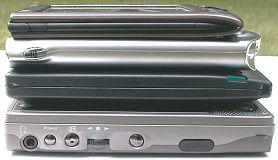
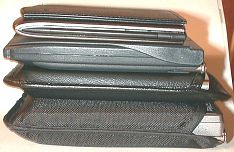
One small complaint that I have about the PDA is that it is almost too smooth as it has a slippery feeling in your hand. You can attach the basic style pack though which does make the unit feel less slippery (more about the packs later) but it increases the overall size of the unit somewhat.
The display on the iPAQ is very nice. It uses a reflective screen like the Aero Palm-size PC. The best thing about the display is that you can use your iPAQ outside in full sunlight. Other color PDAs can't be used comfortably outside. Their screens basically turn black and non-viewable. The iPAQ can be viewed just fine. If you look at the very first picture in this review, it was taken outside on a bright cloudy day. The screen also looks great on a bright sunny day with no clouds. I love the ability to use my PDA everywhere. It's no fun to have to shade or squint at the screen when you are outside. I think that the iPAQ will be popular because of this. It will work great if you want to use it in your car with a GPS for example.
How does the screen compare with the Casio E-115? Well, side by side, I'd say that the Casio has a brighter display with richer colors. There are six brightness settings on the iPAQ, at the highest setting, it is just a bit brighter than the Casio's dimmest setting. The iPAQ is easy and comfortable to read, but I would love for it to be just a little brighter. The iPAQ can only display 4096 colors while the Casio can display over 65,000 colors. Does this matter? Personally, I don't think so. If all you're going to do is use the iPAQ for the built-in applications, you'll be perfectly happy. If you intend to use the iPAQ as a photo album, I think you'll still be happy. You really can't tell THAT much of a difference between 4096 colors and 65,000 colors. There is a difference, but it's not super drastic.
What about the using a stylus on the display? I actually prefer the iPAQ
display to the Casio. The iPAQ is very slick like a piece of glass while the
Casio has a more paper-like feel to it. This is just a matter of personal
preference.
Unlike previous Palm-size PCs and Pocket PCs, the iPAQ has all the controls but one on the front of the unit. The only control not on the front is the voice recorder button which is on the top left side of the PDA. On the front top is the Microphone. The placement makes it easy to pick up the PDA with your right hand, press the voice recorder button with your thumb and talk into the microphone. It's not as
convenient for lefties, but it is still usable. An Ambient Light Sensor is located next to the microphone on the front of the unit. This sensor is supposed to adjust the brightness of the display depending on your surroundings.
I really couldn't tell if the light sensor really did that much. Basically if
you have the brightness setting set at Automatic, it turns the backlight to the
Low setting no matter what lighting situation that you are in. An Alarm/Charge Indicator LED is also at the top front of the unit. This LED will flash yellow when the unit is charging and will glow a steady yellow when the unit is fully charged. It will also blink yellow when an alarm goes off. Next to it is the On/Off/Backlight button. Pressing the button once will toggle power to the unit. Pressing and holding the button will toggle the backlight. This doesn't turn the display off, it just turns off the backlight (same as power save mode). You can still see the display. The button itself is small, recessed and pretty stiff. I find it a little hard to activate and end up using my thumbnail to press it.
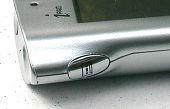

At the bottom front of the PDA are 4 application buttons, the 5-way joystick and the speaker which is under the joystick. Although the 4 buttons can be reprogrammed to launch any application that you choose, they are initially set to launch the Calendar, Contacts, Qmenu and QStart. The outside buttons are a little larger than the inside buttons. They are all easy to press with your index finger and have good tactile feedback. The 5-way joystick is similar to the Casio joypad. But, iPAQ goes one better by letting you press the center of the button to do a select. This joystick is easy to use and works well in all applications. The only thing I don't like about it is that my joystick makes a strange squeaky noise when I rock it to the left or right. It sounds mainly like the spring under it is creaking. I don't like it. But then, I'm picky.
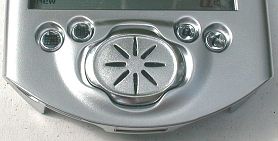
The speaker is housed under the joystick and is the loudest of any of the
"palm sized" PDAs that I've tried so far. I don't think you'll miss an
alarm on this PDA. Listening to .MP3 files thru this speaker won't be optimal
since the speaker isn't stereo. But, it's loud enough to play thru if you want
to. It's also just fine for listening to any voice recordings that you make
using the built-in microphone. The recording quality of the iPAQ is quite good.
You just have to play around with the settings to find the one that you feel
sounds the best.
The top and bottom of the PDA aren't flat but are concave. The top of the iPAQ
has the stylus silo, stylus eject button, IR port, microphone, and earphone
jack. The coolest thing is the stylus eject button. The small oval button next
to the stylus silo when pressed will allow the stylus to pop up so that you can
remove it. This rates pretty high on my nifty feature list. The stylus itself is
a typical stock PDA stylus without much character. It is strangely shaped though.
Sort of egg shaped and so that it can only fit in the stylus silo one way.

The IR port seems to be pretty strong. I did some tests beaming a note file back and forth to my Casio E-115. I used a long flat desk to lay the PDAs on and was able to successfully beam files as much as 64inches away...
Next to the IR port is a tiny hole. I am not sure what this is for. I don't think it is another microphone because I tried covering the mic on the front while recording and recordings came out muffled.
The earphone jack is the standard 3.5mm size. The internal stereo sound on the iPAQ is great. It is about 3-4 times louder than the Casio E-115. The loudest setting on the Casio is equal to turning the volume a third of the way up on the iPAQ. Listening to .MP3s I noticed that the sound on the iPAQ is a little bit brighter than the Casio and the bass is also a bit deeper than the Casio. I'm very happy with the sound quality of the iPAQ except for one little thing. All the system sounds on the iPAQ end with a funny little hiss and a click. Sounds such as tapping on the Start bar or other icons all make this noise. I thought at first that it just might be the built in speaker, but listening thru the headphones you can really hear it. I'm not sure what is causing this but it is a little annoying.

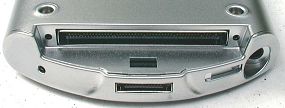
The bottom of the iPAQ has the AC adapter port, On/Off door with a toggle switch underneath, communications port, reset switch and Expansion Pack connector. The AC adapter cable which plugs into the cradle can also plug directly into the AC adapter port. The On/Off door is a sliding cover that hides a toggle switch underneath. You have to toggle the switch when you first get the iPAQ in order to allow the unit to turn on and charge the battery. The communications port mates with the cradle or optional cable. The reset switch can be activated with the tip of the stylus to reset the device. Pressing this button doesn't erase data. The Expansion Pack connector is the connector that all the Expansion Pack sleeves will use. This port is exposed all the time unless you use the basic Expansion Pack sleeve that comes with the iPAQ. It does nothing but cover the back, sides and Expansion Pack slot of the iPAQ. Unfortunately you can't turn the sleeve around to protect the screen. One nice thing is that you can still put the iPAQ in the cradle when this sleeve is on. Although the sleeve does keep the iPAQ from feeling so slippery, it does add a bit to the overall size and weight of the PDA. I would rather see someone create a small plastic cover for the Expansion Pack slot.
![]()
![]()
The Expansion Packs are Compaq's answer to the Handspring Springboard modules. Packs will be available to allow you to use PCMCIA cards and Compact Flash cards with your iPAQ. Other ideas in the works are GPS packs, Cellphone packs, modem packs etc. This is a cool idea but the only bad thing about it is that these packs will cost you extra $$'s, and will add weight and size to your new small PDA. I just wish that Compaq would have included a CF card slot built into the iPAQ, instead of requiring users to buy a separate Expansion Pack for it.
The iPAQ USB cradle is light weight and is made of plastic with aluminum (I think) on the bottom. The iPAQ fits in the cradle easily but requires two hands to remove it. You have to hold on to the cradle while pulling the iPAQ out. There are two stylus holders on the front of the cradle... does anyone ever use these?
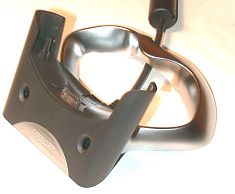
USB is nice and it is quite a bit faster than serial. Syncing the Calendar, Contacts, Tasks and Notes are now much faster. The only bottleneck now is if you sync Avantgo sites. This is still way too slow for my liking... and I only sync 4 to 5 sites. Transferring .MP3 files directly to the iPAQ is tolerable (I wish there was a CF slot though...). I did a couple tests to see how long it would take to transfer a 1meg file and a 5meg file by various methods and media. Here are my findings:
| 1067KB file transfer | 5019KB file transfer | |
| PC to iPAQ via USB iPAQ cradle | 14.04sec | 1min |
| PC to CF card via USB Sandisk CF Card Reader | 3sec | 11sec |
| PC to Casio E-115 via Casio Serial Cradle | 2min 32sec | 9mins 42 sec |
Battery life with the iPAQ seems fine. I don't find battery life to be an issue with this generation Pocket PCs. Just stick the PDA in the cradle to charge a few minutes every other day or so and you'll not have a problem.
The overall system speed of the iPAQ is excellent. It is FAST. I recently read an article that reported some actual benchmark data comparing the iPAQ, Casio E-115 and HP 545 and from this I was led to believe that the iPAQ's StrongARM processor wasn't all that superior speed-wise. Well, I was very pleased to find that real world use has revealed to me that the iPAQ is the fastest Windows Powered Pocket PC device yet. All the main built-in apps pop up instantly. The larger apps such as Pocket Excel, Pocket Explorer, Pocket Word and Microsoft Reader have a very slight lag to start with the Microsoft Reader being the slowest to start. That said, to me, the iPAQ really feels about twice as snappy as my Casio E-115. I'm very happy with the speed.
Let's look at the software side of things now. I won't go over the basics of the new apps that are built into the Pocket PCs. If you want to read more about Pocket Word, Pocket Excel, Microsoft Reader and the others, check out my review of the Casio E-115 where I did go into some details.
One of the great things about the iPAQ is that the OS is in Flash ROM. This means that you can update it with patches or even replace it totally. People are already playing around with loading Linux on their iPAQs. Palm have been doing this for awhile with their PDAs and I think it is a very good thing.
What software goodies come with the iPAQ?
Software:
These are all apps built into the OS:
Calendar, Contacts, Pocket Excel, Pocket Word,
Tasks, Voice Recorder, Notes, Pocket Internet Explorer,
Calculator, Solitaire,
Inbox, File Explorer, Media Player
These are on the Microsoft CD-ROM:
ActiveSync 3.1, Microsoft Outlook� 2000,
Pocket Streets, Transcriber, Microsoft Money, Windows Media Manager,
Microsoft Reader eBooks, Internet Explorer 5.0
These are the extras that Compaq put in the iPAQ ROM:
QMenu, Asset Viewer, Qstart,
QUtility Picture Viewer, Backup
These are the extras on the Compaq CD-ROM:
Pocket Asset Manager, Reference Guide (pdf format) and Virtual Tour,
AudiblePlayer and AudibleManager,
Ilium eWallet and ListPro
QMenu is a pop up task switcher and task closer tool. One of the hardware buttons on the front of the iPAQ is mapped to this tool by default. Qstart is Compaq's Program Launcher program. This program will allow you to add your own categories that can be accessed from a pop up list at the bottom of the screen. Qstart is also mapped to one of the hardware buttons by default. It's a quick launcher and is easy to use. Asset Viewer gives you simple outline view of the iPAQ hardware details. Picture Viewer is a very simple graphics viewer. Backup allows you to back up all your data to a CF card... which you won't be able to use unless you buy an optional Expansion Pack.
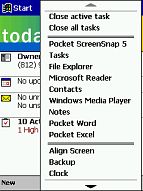
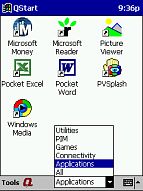
The optional files that you can install from the Compaq CDrom are eWallet and ListPro from Ilium Software. eWallet allows you to store your personal information such as credit card numbers, passwords, pin numbers etc. ListPro allows you to create hierarchical lists and outlines.
There is a splash file on the iPAQ for a program called PacketVideo Player. This program is supposed to be a streaming video player. The splash screen tells you to go download the latest version from their website or install it from the enclosed CDrom. The file doesn't exist on the CD and the website says the program will be available next month... The Compaq CD also shows a program called Formula 1 which looks like a race car game. But, this game isn't available to install. I'm somewhat disappointed in the software bundle. It would have been great to get a couple more freebies.
Overall, I really like the iPAQ. For me it would be perfect if a compact
flash slot was built in and if the screen were just a bit brighter and the
colors more vivid. Other than that, I think Compaq has created the best Pocket
PC so far. The only little gotcha is that some third party shareware apps aren't
available for the iPAQ yet. I think that will change very quickly though. I
haven't been able to review the HP Pocket PC yet, but from what I can guess, the
iPAQ is the one to beat right now. It's just replaced my Casio E-115 as my main
PDA.
Price: $499
Pros:
Small
Fast
Expansion Slots
Flash ROM
Screen viewable outside in direct sunlight
Cons:
No Compact Flash slot built in
Small software bundle
Not many shareware apps available yet for this processor
| Let me know your comments
on the iPAQ and read what others have to say. |